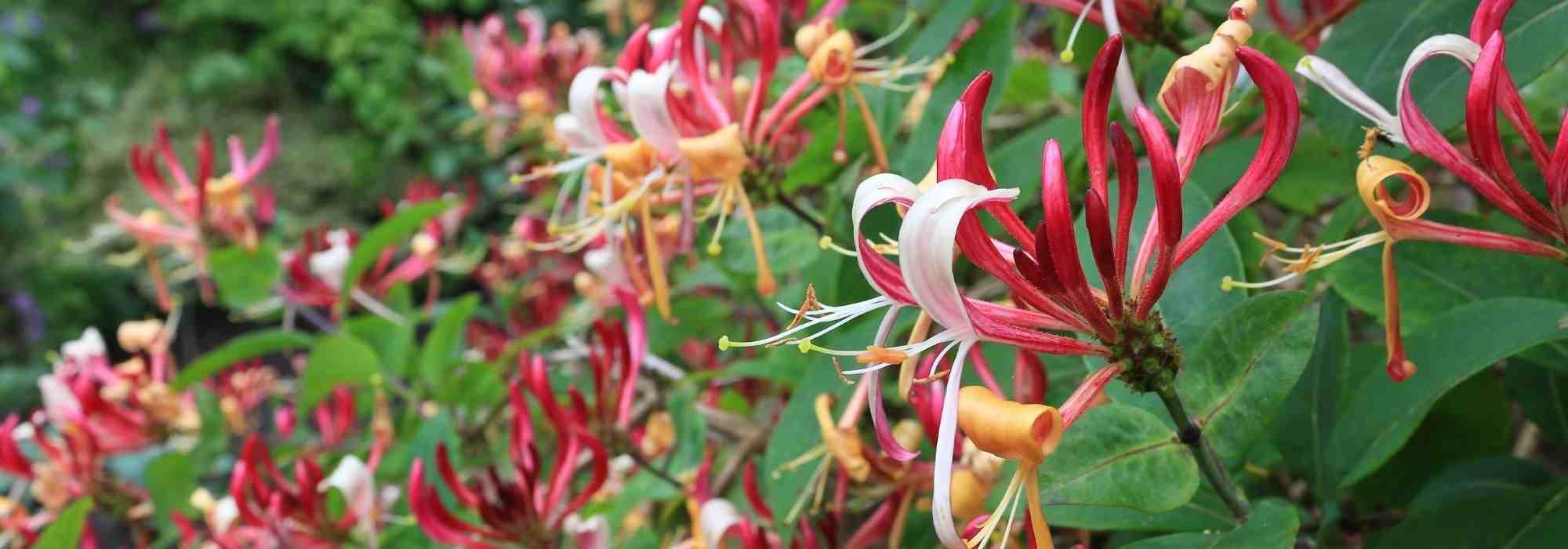
Choosing a Honeysuckle
Our buying guide to make the right choice
Contents
Filling the garden or terrace with an exquisite fragrance, the climbing Honeysuckle is a pure delight for gardeners. Easy to grow and requiring little maintenance, Lonicera beautifully decorates all supports. This climbing plant is also highly sought after for its colourful summer flowering, which can sometimes change throughout the season. Deciduous, semi-evergreen, or evergreen, a wide range of Honeysuckles is available to you, as the genus Lonicera includes nearly 200 species, both climbing and shrubby. Plant size, growth, flowering, fragrance, uses, etc. The characteristics are numerous, and it can be challenging to navigate. Discover our tips for choosing a Honeysuckle that meets your expectations.
→ Discover also our article: Honeysuckle, the most beautiful varieties.
According to its size
Size is an important criterion to consider, as the choice of honeysuckle depends on the space you have available. Honeysuckles are generally large climbing plants. However, there are a few small varieties that are interesting for smaller areas. Here are some examples from our collection:
Small honeysuckles under 2 m tall
Of modest size, they are useful in small gardens or for covering small areas: the Lonicera periclymenum ‘Chic et Choc’ does not exceed 1 m in height and 60 cm in spread. A bit taller, the Lonicera henryi ‘Copper Beauty’ grows up to 2 m tall and 1.5 m wide. Both are perfectly suited for pot planting, ideal for modest balconies and terraces.
Medium honeysuckles 2 to 4 m tall
For example, the highly floriferous Lonicera ‘Caprilia Impérial Cov’ climbs up to 2.5 m and spreads to 1.5 m. The very hardy Lonicera ‘Mandarin’ reaches up to 3 m tall with a width of 4 m. Both Lonicera sempervirens ‘Cedar Lane’ and Brown’s climbing Honeysuckle exceed 3.5 m in height.
Large honeysuckles over 4 m tall
At maximum, they can reach 10 m in height and cover a wall up to 4 m wide. In our catalogue, there are many Honeysuckles around 4 m tall, including: Lonicera heckrotii ‘American Beauty’, Lonicera similis var. delavayi, and Henry’s Honeysuckles. Approximately 5 m tall, the Tellman Honeysuckle and Lonicera periclymenum ‘Serotina’. Finally, among the tallest exceeding 6 m, several Japanese Honeysuckles can be found, including Lonicera japonica ‘Sinensis’.
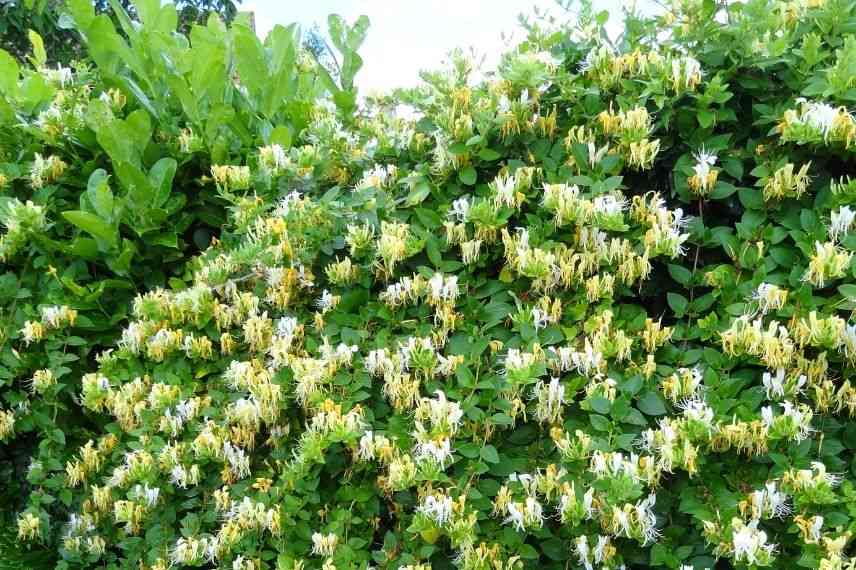
Lonicera japonica ‘Halliana’ can reach over 6 metres tall
According to its vigour
Honeysuckle uses its voluble stems to climb on its support. Some are more vigorous than others and quickly adorn trellises, pergolas, arches, or fences. Here are some examples of fast growth:
- The evergreen Lonicera similis var. delavayi, climbing up to 4 m in height;
- The highly floriferous Lonicera periclymenum ‘Belgica Select’ with significant growth (5 m tall);
- The fragrant Lonicera henryi ‘Caprilia Ever’;
- The semi-evergreen Lonicera japonica ‘Red World’ and the very hardy Lonicera japonica ‘Hall’s Prolific’ reaching up to 6 m tall at ripeness;
- The compact Lonicera japonica ‘Sweet Isabel’ growing 3 m in all directions at adult size;
- The Lonicera (x) brownii with vibrant flowering, of medium size.
In contrast, the Lonicera henryi and its variety ‘Copper Beauty’, as well as the small Lonicera periclymenum ‘Chic et Choc’ have a slow growth. So patience!
Discover other Honeysuckle
View all →Available in 2 sizes
Available in 2 sizes
Available in 2 sizes
Available in 1 sizes
Available in 1 sizes
Available in 1 sizes
Available in 1 sizes
Available in 2 sizes
Available in 1 sizes
Available in 1 sizes
According to the colour of the flowers
Honeysuckles offer a wide range of shades: white, pink, red, orange, yellow. Often changing colour during their development, the trumpet-shaped flowers can be bicoloured or multicoloured.
Honeysuckles with white flowers
In this category, we can mention Woodbine ‘Graham Thomas’, Japanese Honeysuckle ‘Halliana’, or Lonicera japonica ‘Aureoreticulata’, which produce cream-white flowers at blooming that turn pale yellow over time.

Lonicera periclymenum ‘Graham Thomas’
Honeysuckles with pink or red flowers
In shades dominated by pink, we find, for example, Lonicera hybrid ‘Celestial’, which is slightly violet and orange. Lonicera heckrotii ‘American Beauty’ displays a brighter pink with a hint of yellow. Very vibrant, red honeysuckles bring dynamism to gardens: Lonicera sempervirens ‘Cedar Lane’, Red Orange Climbing Honeysuckle ‘Dropmore Scarlet’, and Brown’s Honeysuckle.

Lonicera heckrotii ‘American Beauty’
Honeysuckles with yellow or orange flowers
Yellow Loniceras come in various shades. Lonicera similis var. delavayi and Lonicera Japonica ‘Mint Crisp’ are dressed in pale yellow and white. Positioned between yellow and orange, Honeysuckle x brownii ‘Golden Trumpet’ and Tellman’s Honeysuckle are very warm. Finally, Lonicera ‘Mandarin’ and Brown’s Honeysuckle are very vibrant and bring energy to the garden.
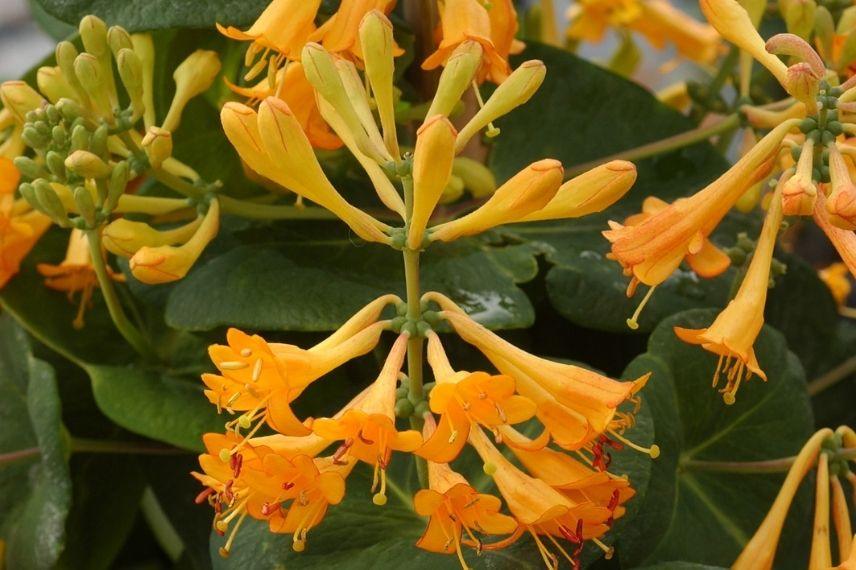
Lonicera brownii ‘Golden Trumpet’
Honeysuckles with bicoloured or multicoloured flowers
Special mention for honeysuckles with particularly remarkable flowering:
- The Woodbine ‘Serotina’ offers a bicoloured flowering of cream white and dark red;
- The Dwarf Honeysuckle ‘Chic et Choc’ features a pinkish white flowering that gradually turns yellow-orange;
- The Lonicera periclymenum ‘Belgica Select’ reveals tricoloured flowers: cream white, yellow, and striped with pink.

Lonicera periclymenum ‘Serotina’ (photo Javoy Plantes)
Read also
How to grow Honeysuckle in a pot?According to the size of the flowers
The size of Honeysuckle flowers varies between 2 and 7 cm depending on the species and varieties.
- The Lonicera tellmaniana and Lonicera sempervirens ‘Cedar Lane’ are distinguished by their large flowers that can reach up to 6 – 7 cm. Unfortunately, these are not fragrant.
- In contrast, the Lonicera japonica ‘Aureoreticulata’ bears small flowers of 2 cm, and is mainly planted for its interesting foliage. The woodland Honeysuckles ‘Graham Thomas’, ‘Chic et Choc’, and ‘Scentsation’ produce fragrant tubular flowers of 3 cm.
- There are many Loniceras with intermediate-sized flowers (4 – 5 cm). The most well-known include Lonicera (x) heckrotii ‘American Beauty’ and ‘Gold Flame’ with their spicy 5 cm flowers, as well as Lonicera japonica ‘Hall’s Prolific’ featuring 4 cm flowers with the scent of jasmine and lily of the valley.
According to its foliage
Deciduous, semi-evergreen or evergreen, the foliage is often green, varying from dark to medium green (dark green for Delavay honeysuckle, medium green for Lonicera caprifolium) or sometimes bluish-green as seen in Heckrotii honeysuckle ‘Gold Flame’. The Henry honeysuckle ‘Copper Beauty’ features evergreen bluish-green foliage with brownish highlights.
It is worth noting that some honeysuckles develop variegated foliage:
- The Lonicera x italica ‘Harlequin Sherlite’, deciduous, has green foliage variegated with white, sometimes pink at the edges.
- Semi-evergreen, the Lonicera japonica ‘Aureoreticulata’ bears light green leaves with well-defined yellow veins. A beautiful contrast is formed on the lamina for this highly decorative variety.
- Finally, with its evergreen foliage, the Lonicera japonica ‘Mint Crisp’ remains bright all year round thanks to its leaves speckled with green and yellow.
For gardeners seeking a honeysuckle that retains its leaves during winter (evergreen), here are a few options: Lonicera sempervirens ‘Cedar Lane’, Lonicera similis var. delavayi, Henry honeysuckles, the Woodland honeysuckle ‘Caprilia Ever’, and Japanese honeysuckles ‘Hall’s Prolific’ and ‘Sweet Isabel’. These can create effective screens on a fence or trellis, for example.

Foliage of Lonicera similis var. delavayi, Lonicera henryi ‘Copper Beauty’ (Copyright Minier), Lonicera japonica ‘Mint Crisp’ and Lonicera japonica ‘Aureoreticulata’
According to its fragrance
Honeysuckle offers us its abundant flowering for many months, from spring to autumn. Its flowers emit, especially in the evening, a sweet or spicy floral fragrance that attracts foraging insects. Among the most fragrant and in yellow hues, we find the Father Delavay’s Honeysuckle, Lonicera periclymenum ‘Scentsation’ with its powerful scent sensations, Lonicera japonica ‘Hall’s Prolific’, and the Japanese Honeysuckle ‘Halliana’ with its sweet fragrance. Generally, it is the wood honeysuckles that are the most fragrant (Lonicera periclymenum).
Note that Henry’s Honeysuckles, as well as the Japanese Honeysuckle ‘Aureareticulata’, are not very fragrant. The Tellman’s Honeysuckle, Brown’s Honeysuckle, and Lonicera sempervirens ‘Cedar Lane’ are not fragrant.
→ Discover our selection of the most fragrant honeysuckles.
According to its flowering period
Generally, most varieties bloom between June and September (for example, Japanese Honeysuckles ‘Halliana’ and ‘Mint Crisp’ or the Wood Honeysuckle ‘Sinensis’). However, some varieties are earlier:
- the Garden Honeysuckle (Lonicera caprifolium) blooms in spring, from April to May;
- Tellman’s Honeysuckle and Lonicera ‘Mandarin’ bloom from May to July;
- the Lonicera x italica ‘Harlequin Sherlite’ with variegated foliage produces its flowers from May to September.
According to fruiting
After flowering, globose fruits appear. While birds love them, they are toxic to humans and therefore not edible. These berries can be red or black and have an aesthetic appeal. For example, Lonicera periclymenum ‘Belgica Select’ and ‘Scentsation’ are very decorative with their clusters of red fruits. The blue-black berries of Henry’s Honeysuckle ‘Caprilia Ever’ remain present long after flowering.
According to the use
- In the garden, in partial shade, climbing Honeysuckles are excellent plants for dressing up a fence, gazebo, tree, or a wall exposed to the East. Choose according to the size of your outdoor space. For a large area, you can opt for a larger specimen.
- On a terrace or balcony, it brings greenery, a natural touch, and can even obscure the view from prying eyes. Choose a Honeysuckle suitable for pot cultivation and with modest growth. Don’t forget to guide it on a wooden trellis, for example.
- You can also plant it at the base of shrubs forming a hedge. Its stump is in the shade and benefits from the coolness of the soil. Intertwine its voluble stems among the branches of the shrubs, which will be enhanced by its summer flowering.
- To cover a bank, opt for the Japanese Honeysuckle ‘Halliana’, which is just right. Indeed, its vigorous and long lianas can quickly invade the soil of large spaces.

Whether on a fence, near a window, or on a wall, Honeysuckle easily and quickly decorates spaces while allowing us to enjoy its pleasant fragrance.
- Subscribe!
- Contents
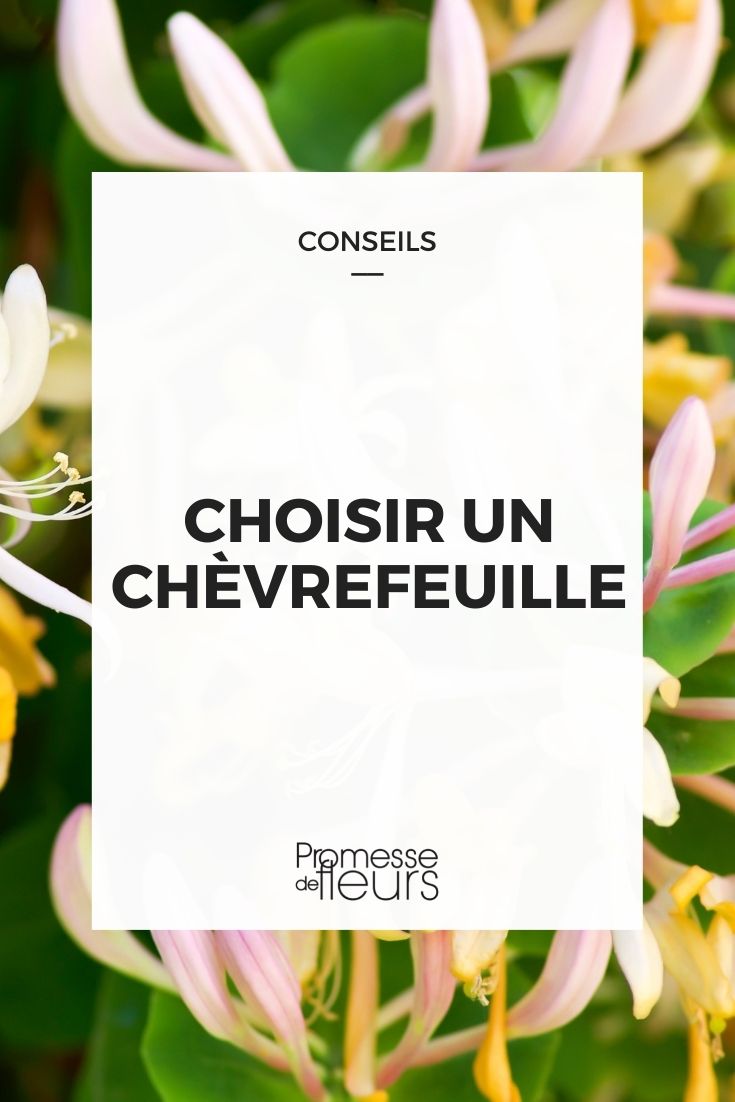































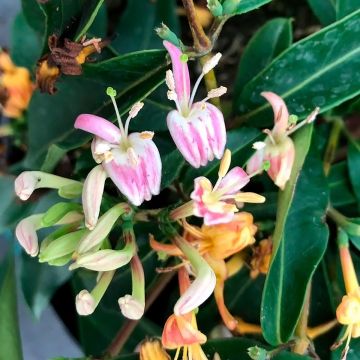

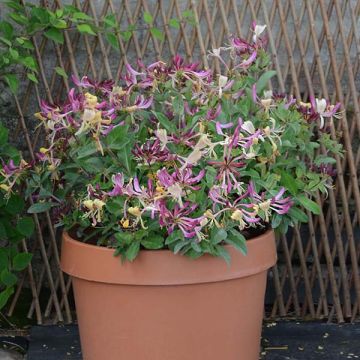

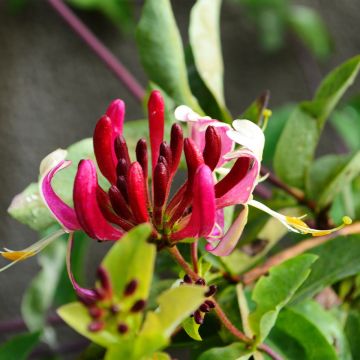
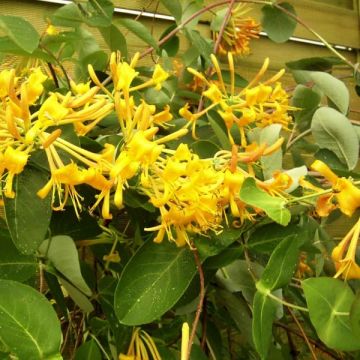
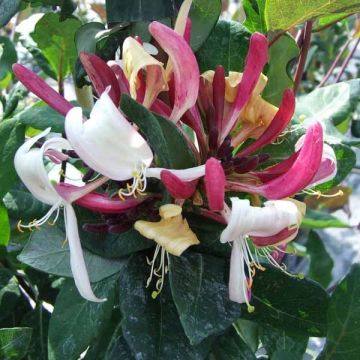


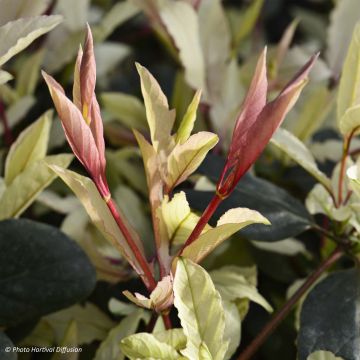
Comments